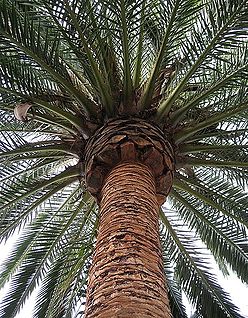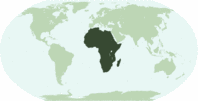Phoenix canariensis
| Phoenix (FEH-niks) canariensis (kah-nahr-ee-EN-sis) | ||||||||
|---|---|---|---|---|---|---|---|---|
 San Leandro, California. Photo by Kelley MacDonald. | ||||||||
| Scientific Classification | ||||||||
| ||||||||
| Synonyms | ||||||||
|
| ||||||||
| Native Continent | ||||||||
|
| ||||||||
| Morphology | ||||||||
| ||||||||
| Culture | ||||||||
| ||||||||
| Survivability index | ||||||||
|
| ||||||||
| Common names | ||||||||
|
Palmera Canaria (Español). | ||||||||
Contents
Habitat and Distribution
Canary Is., Norfolk Is., Spain. Phoenix canariensis is endemic to the Canary Islands and occurs, scattered in populations of varying sizes, on all seven islands. The largest populations of wild palms are found on La Gomera. From sea-level up to 600 m in a range of habitats, from humid areas just below cloud forest to semi-arid areas where its presence usually indicates groundwater. Ecological requirements of P. canariensis were extensively studied by Liipnitz & Kretschmar (1994). In its native habitat P. canariensis flowers during the spring and fruits ripen in the autumn. (S.C. Barrow. 1998)/Palmweb.Description
Single-trunked, pinnate palm to 20 m (66 feet) or more tall; exceptionally tall specimens can be up to 40 m (120 feet). The trunk is 60 - 90 cm (2-3ft) in diameter, often with a much wider base. Rounded crown of dark green feather leaves 4-6 m (18 feet) long, with pinnae to 20-40 cm long closely spaced along the rachis. Like all Phoenix, P. canariensis has long, extremely sharp spines at the bases of the leaves, which are formed from modified leaflets. The species is dioecious, with separate male and female trees. The fruit are orange, 2 cm long and 1 cm diameter, with a large seed; the fruit pulp when ripe (solid black) is edible, but usually too thin to be worth eating. They are produced on long, densely branched panicles.
Solitary palm. Trunk to 15 (20) m tall, without leaf sheaths to 120 cm in diam.; trunk dull brown, marked with broad, diamond-shaped leaf base scars. Leaves arching, 5 - 6 m long; leaf base 25 - 30 cm wide; pseudopetiole to one fifth of total leaf length; leaf sheath reddish-brown, fibrous; acanthophylls proximally congested in arrangement, pointing in several directions, green when young, becoming yellow, to about 20 cm long, conspicuously folded (conduplicate); leaflets closely and regularly inserted in one plane of orientation, to about 200 on each side of rachis, often forward-pointing, about 25 - 30 cm long; lamina concolorous, bluish-green, with adaxial and abaxial surfaces glabrous. Staminate inflorescence erect; prophyll splitting twice between margins, yellow-green with reddish-brown tomentum when young becoming brown and coriaceous, to about 40 cm; peduncle to about 50 - 70 cm long. Staminate flowers crowded along full length of rachillae; calyx an even-rimmed cupule, 1.5 - 2 mm high; petals to 6 x 3 mm, with apex rounded and minutely serrate. Pistillate inflorescence initially erect, becoming pendulous; prophyll splitting between margins, yellow-green, to 60 x 10 cm; peduncle yellow-green, elongating with maturity, 1.6 - 2 m long; rachillae yellow, elongating with fruit maturation, to about 60 cm long. Pistillate flowers mostly in distal half of rachillae, yellow-white, with faintly sweet scent; calyx cupule about 2.5 mm high; petals about 3 x 4 mm. Fruit obovoid, 1.5 - 2.0 x about 1.2 cm, ripening from yellow-green to golden-yellow. Seed ovoid in shape, about 15 x 10 mm, with rounded apices; embryo lateral opposite raphe; endosperm homogeneous. (S.C. Barrow. 1998)/Palmweb. Editing by edric.
| read more |
|---|
|
In the classical literature a reference to P. canariensis was given by Pliny (see Hort 1916) as Palmeta caryotasferentia, who reported the observation of Juba that'...Canaria also abounds in palm groves bearing dates.' Webb & Berthelot (1847) were the first to recognise differences between the Canary Island palm and the date palm, describing the former as P. dactylifera var. jubae Webb & Berthel. Christ (1885) later gave the palm species status as P. jubae (Webb & Berthel.) D. H. Christ. Neither name was in common use by the horticultural trade who tended rather to adopt the unpublished names P. cycadifolia and P. canariensis (e.g., Neubert 1873). The name P. cycadifolia was validated by Regel (1879) with a brief description and illustration of a palm growing in Athens. The name P. canariensis was validated by Chabaud (1882) with a description and illustration of a cultivated palm grown from seed of Canary Island origin. Despite the robust nature of the 'canariensis-like' palm depicted in the illustration of Regel (1879), Beccari (1890) considered P. cycadifolia to be a synonym of P. dactylifera. I agree with Moore (1971a) in considering the illustration of R cycadifolia to be more similar to P. canariensis than P. dactylifera, and thus consider it a synonym of the former. The name P. cycadifolia predates P. canariensis by three years, should thus take nomenclatural precedence but because of the doubt surrounding the identity of P. cycadifolia, and the great familiarity of botanists and the horticultural trade with the name P. canariensis, I follow Moore (1963a) in maintaining the latter as the accepted name for the Canary Island palm. (S.C. Barrow. 1998)/Palmweb. |
Culture
Within the limits of its hardiness (down to about -10°C) P. canariensis is adapted to more habitats and soils than almost any other palm. This, combined with its relative hardiness to cold, make it one of the most widely-planted palms on Earth. Excellent specimens can be found from London to Sydney, from Honolulu to Pakistan, from Tasmania to Durban, and almost anywhere else with a suitable climate. Which is a wide swath of the world.
Best in Mediterranean climates, like those in Italy, southern California, Chile, etc., P. canriensis will also grow in the tropics. Fine stalwart specimens can even be found in cool (but not cold) maritime climates like Northern Ireland, Tasmania, or San Francisco.
While best in full sun and the usual well-drained loamy soil, P. canariensis can tolerate a wide range of exposures, including deep shade, and a wide range of soil types, including sand and heavy clay. It has a unique ability to tolerate both severe drought and flooding very well, which makes them ideal to plant in housing tracts in which the soil was heavily compacted.
In ideal conditions, seedlings grow pinnate leaves within about a year from sprouting, and increase to full width in about 5 years, at which point they begin to form a trunk. They can then put on about 30 cm (12") trunk height growth a year, though they are usually much slower, particularly when young.
In climates cold enough to freeze the entire crown (such as parts of New Mexico), regrowth is slow and often stunted. In popular use, the English name is often abbreviated to the acronym "CIDP".
Comments and Curiosities
Uses: Phoenix canariensis is extensively cultivated in warm temperate regions as a street tree or garden plant. The leaflets are used in much the same way as those of P. dactylifera for a range of woven products including crosses for Palm Sunday celebrations. Inflorescence buds are tapped for the sweet sap which is eaten as palm honey. Mifsud (1995) reported an unusual use for leaves of P. canariensis in Malta where fishermen attract pilot and dolphin fish by floating two or three palm leaves on the sea surface near their nets. These fish species are known to congregate under floating objects and so are easy prey beneath the palm leaves. (S.C. Barrow. 1998)/Palmweb.
| read more |
|---|
|
Conservation: The greatest threat to P. canariensis is an increase in cultivation of exotic species of Phoenix on the Canary Islands and contamination of the native species with alien genetic material. The ease with which species of Phoenix hybridize in cultivation is well known (Corner 1966; Hodel 1995), and the large number of horticultural names associated with 'canariensis-like' palms reflects the number and variety of hybrids in existence. Phoenix dactylifera and P. roebelenii have long been in cultivation on the Canary Islands and in recent years other exotic species of the genus have been introduced. Hybridization between P. canariensis and R dactylifera poses the biggest problem due to the difficulty of early detection and removal of the resulting hybrids. The recent ban on the importation of exotic species of Phoenix should help lessen the hybridization threat. Importation of palms known to carry the pathogen that causes Lethal Yellowing may also pose a threat to wild populations of P. canariensis. (S.C. Barrow. 1998)/Palmweb. Uses: Phoenix canariensis is extensively cultivated in warm temperate regions as a street tree or garden plant. The leaflets are used in much the same way as those of P. dactylifera for a range of woven products including crosses for Palm Sunday celebrations. Inflorescence buds are tapped for the sweet sap which is eaten as palm honey. Mifsud (1995) reported an unusual use for leaves of P. canariensis in Malta where fishermen attract pilot and dolphin fish by floating two or three palm leaves on the sea surface near their nets. These fish species are known to congregate under floating objects and so are easy prey beneath the palm leaves. (S.C. Barrow. 1998)/Palmweb. Specimens are sometimes trimmed to remove the lower leaves, this creates a pineapple effect. "This is the classic avenue palm in Southern California (aside from the Mexican Fan Palm)- there are thousands of them lining the streets all over Los Angeles. It is one of the fastest growing, largest and hardiest palms you can grow. It seems to like Mediterranean climates better than tropical ones- those grown in Florida always look a bit anemic to those in drier climates. Once established it needs no water, and will look good in high heat and freezing cold. It does have a few drawbacks, however. Until the crown grows over your head, or the roof of your home, you will need to contend with long, spiny leaves, the base of which have strong, sharp spines that look like darning needles up to 2 feet long that can easily penetrate the toughest clothing- even leather... so careful when pruning! It also is susceptible to Fusariam Wilt, a fungal disease that is spread by pruning with 'infected' shears/pruners. All those pruning multiple palms are urged to clean the instruments with bleach or something that kills the fungus." (Geoff Stein) |
- IMAGE GALLERY
In front of the Dept. of sanitation's lift station or whatever it is, it's some kind of sub-station on the north causeway in New Smyrna Bch., a little southwest of Venezia on the south side of the causeway, there are Phoenix canariensis that have little di-cot's and ferns, and Lantanna bushes growing out of their leaf remnants. Photo by edric.
|In front of the Dept. of sanitation's lift station or whatever it is, it's some kind of sub-station on the north causeway in New Smyrna Bch., a little southwest of Venezia on the south side of the causeway, there are Phoenix canariensis that have little di-cot's and ferns, and Lantanna bushes growing out of their leaf remnants. Photo by edric.
In front of the Dept. of sanitation's lift station or whatever it is, it's some kind of sub-station on the north causeway in New Smyrna Bch., a little southwest of Venezia on the south side of the causeway, there are Phoenix canariensis that have little di-cot's and ferns, and Lantanna bushes growing out of their leaf remnants. Photo by edric.
In front of the Dept. of sanitation's lift station or whatever it is, it's some kind of sub-station on the north causeway in New Smyrna Bch., a little southwest of Venezia on the south side of the causeway, there are Phoenix canariensis that have little di-cot's and ferns, and Lantanna bushes growing out of their leaf remnants. Photo by edric.
In front of the Dept. of sanitation's lift station or whatever it is, it's some kind of sub-station on the north causeway in New Smyrna Bch., a little southwest of Venezia on the south side of the causeway, there are Phoenix canariensis that have little di-cot's and ferns, and Lantanna bushes growing out of their leaf remnants. Photo by edric.
External Links
References
Phonetic spelling of Latin names by edric.
Special thanks to Geoff Stein, (Palmbob) for his hundreds of photos.
Special thanks to Palmweb.org, Dr. John Dransfield, Dr. Bill Baker & team, for their volumes of information and photos.
Glossary of Palm Terms; Based on the glossary in Dransfield, J., N.W. Uhl, C.B. Asmussen-Lange, W.J. Baker, M.M. Harley & C.E. Lewis. 2008. Genera Palmarum - Evolution and Classification of the Palms. Royal Botanic Gardens, Kew. All images copyright of the artists and photographers (see images for credits).
S.C. Barrow, A Monograph of Phoenix L. (Palmae: Coryphoideae). 1998. A Monograph of Phoenix L. (Palmae: Coryphoideae). Kew Bulletin, Vol. 53, No. 3 (1998), pp. 513-575.
Many Special Thanks to Ed Vaile for his long hours of tireless editing and numerous contributions.






















































































